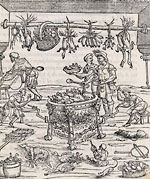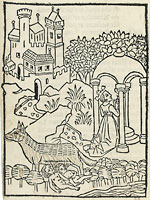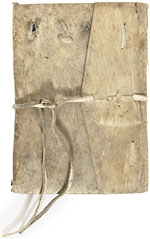From Incunabula to Modern Firsts—What’s Cooking at Auction
Feasting in Ferrara
Cristoforo di Messisbugo, Banchetti compositioni di vivande, et apparecchio generale, £10,000 ($15,275) at Sotheby’s London on July 15.
One of the earlier works in the superb collection of cookery books formed by the reclusive American art collector Stanley J. Seeger, this is the work of a man who worked at the Este court in Ferrara as a scalco, or steward and carver, and whose much appreciated services were rewarded in 1553 when he was appointed a Count Palatine by Charles V.
In a book that was first published in Ferrara in 1549, a year after his death, Messisbugo lists over 300 recipes and also describes the entertainments that took place during the feasting at court. Reproduced here is one of three woodcut illustrations (one of them a portrait of the author) from the Seeger copy, which was in a modern limp vellum binding with leather ties. The price was a low estimate one, but the repaired title page bore a library stamp and had part of the date supplied in pen facsimile.
A Pocket Guide to the Eternal City
Historia et descriptio urbis Romae, £163,250 ($246,820) at Christie’s London on July 7.
In the fifteenth century, tens of thousands of pilgrims would travel to Rome for Easter Week, and the demand for a practical guide was met locally in manuscript, xylographic (block-book), and typographic form. Nowadays, any early printed edition of this standard text is rare, but for a copy of this pocket guide to have survived in almost pristine condition in its original flexible vellum, wallet-style binding is almost as miraculous as the sites it describes.
The principal aim of these guides was devotional in directing pilgrims to the city’s many churches, but in its descriptions of more than 80 churches and the relics they contained, they also contained much secular information, including art historical detail.
As many as 100 editions, including translations into major European languages, are recorded from the last three decades of the fifteenth century, but few are known in more than single, or at best a handful of copies. This example from the Arcana collection of illuminated manuscripts and early printed books was issued c.1485-89 in Rome by Andreas Freitag and illustrated with four woodcuts that were cut down from a German-language block-book edition of c.1475. It is known in half a dozen copies—but half of those are imperfect.
Once in the library of the Jesuit college at Krumau in Bohemia, this incunable was last seen at auction in 1978, when as part of the huge Estelle Doheny library, it sold to Quaritch at Christie’s New York for $143,000.








 Ian McKay’s weekly column in Antiques Trade Gazette has been running for more than 30 years.
Ian McKay’s weekly column in Antiques Trade Gazette has been running for more than 30 years.


